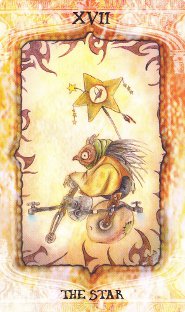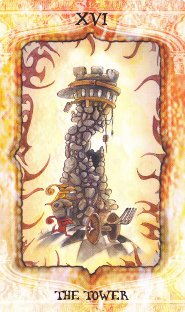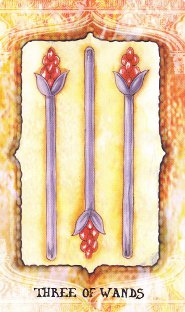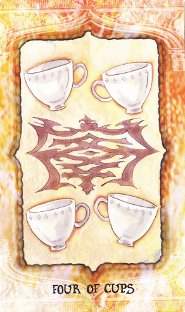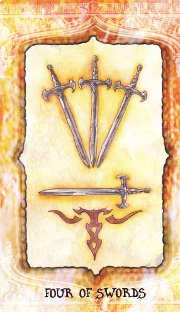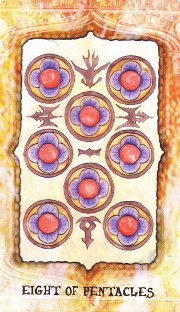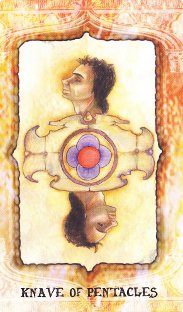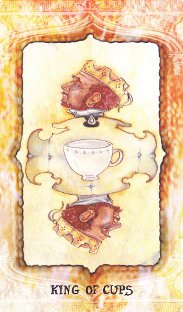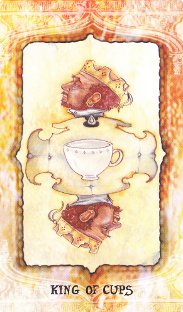7th World Tarot Deck Review
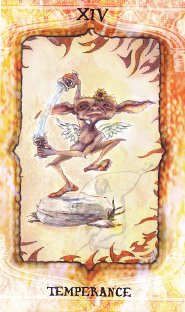
Creators: Terry Whidborne
Published: 2010
The 7th World Tarot is a self-published Australian deck of 80 cards (the conventional 78 plus two Jokers). The art of the majors as a fantastical edge, while minor arcana are unillustrated pips instead of scenic cards.
Retailers
See Price at 7th World7th World Tarot Review by Nisaba Merrieweather
After the episode of "The Collectors" featuring my Tarot collection was aired on ABC-1 a short while ago, I was contacted by the creator of this deck, who was happy to give me a copy to keep in my collection. Self-published in a print-run of just 100 copies, it has not found distribution outlets or a mainstream publisher yet, and I think it richly deserves to find an outlet, plus mass-publication.
The deck as it is in this first print-run, is presented in a simple white box with no artwork, sealed with stickers on which the title of the deck, contact details and a simple logo of a bug with outstretched wings are printed very simply and plainly.
On opening the deck, I was pleasantly surprised to find that the Minor Arcana are the first cards you see, with the Major Arcana at the rear of the deck. For some reason which I haven't really analysed yet, this pleased me greatly; it's as if the deck doesn't need to show off its more glamorous side to attract one in the first place.
And overall, it is an attractive deck. The cardstock is sturdy and gently laminated, and its new-deck-smell is different to the variety of chemical smells that most laminated decks gas-off, instead smelling refreshing and somewhat citrusy. The backs are a simple design in red-ochre, yellow-ochre and black featuring that same bug, in the manner of a woven mat, and are warm and appealing.
Throughout the deck, Majors and Minors all have a broad, elaborate border in ochres, yellows and browns, with a scorched and slightly fantastical edging, placing the image at one remove from the observer and set deep within their own world.
The Minor Arcana cards are unillustrated but subtly decorated, allowing one's intuition more free rein than illustrated pictures do in my opinion, as the observer is not locked into the artist's idea of what the card is about. Wands feature freehand-drawn rods with a burst of ripening grain at the end, simple and more appealing than if the artist had used a ruler to make them perfectly straight. Swords feature a simple, double-sided blade with a basic hilt and a spiral handle forged from the same piece of metal, again drawn freehand. But attractive as these suits are, Pentacles and Cups are where the Minors come into their own. Cups feature cafe-style coffee-cups. I don't know why that surprised and pleased me so much, but it really did. It's as if this deck is more down to earth than decks with showier goblets. And Pentacles are a brown circle, infilled with yellow-ochre, centred with a four-petalled purple flower with a red centre. The floral nature of these Pentacles again veers away from the showy, ceremonious nature of many other Pentacles, towards an earth-based, fertility-based idea, bedded deep in the colours of the country the deck was designed in.
The Court Cards are reversible, busts of individuals usually seen in profile around the symbol of their suit, rather like the court cards in playing decks. Unlike playing cards, though, there is plenty to go on in the expressions and postures of these people to give you divinatory clues. What I like is the cohesiveness of the Court Card characters: cards like the Queen Pentacles and the Knave Pentacles (this deck has Knaves instead of Pages) could be members of almost any race on earth, cards like the King Wands could be anything from Asian to Native American, while the King Pentacles is unashamedly Aboriginal - yet all of the faces, different though they are, seem to come from the same reality the same culture, even the same race - Human.
Along with the reversible, mirror-image Courts, there is something else marrying this deck to commonplace playing cards - the two Jokers. Yes, we have an eighty-card deck here, with no title cards but instead two Jokers. They are identical - I am not even going to begin to describe this card to you - it looks different every time I see it. Needless to say, in my copy and my use of it I'm treating it as a twenty-third Major Arcana card, and leaving both of them in the deck. I've often thought that the Fool card as we experience it in most other decks should really be two separate cards: one indicating the beginning of human consciousness, ignorance, the start of the learning process, and another indicating a state of being experienced but being untouched and uncorrupted by the world. In my own deck which I haven't found an artist for yet, I call the former "The Barbarian" and the latter "The Jester". In this deck, they are The Fool and the Joker, and the cards work well on that level.
In the Major Arcana the range of humans we see in the Court Cards gives way to the non-human, undeniably removing us from the day-to-day and dumping us slap-bang in the middle of the archetypal. Throughout, the "human" roles in the Major Arcana are filled by skinny, long-limbed, floppy-eared, cherry-nosed Tolkienesque earthern-folk who are really very appealing.
Cards I am particularly drawn to? Justice is naked and evidently male, blindfolded and balancing a Sword on his forehead, pieces of a broken yin-yang symbol spinning on strings from its hilt. The Hanged Man is a marionette, hung from strings attached to his elbows, knees and pointy hat. Death is a fantastical crysalis with teeth (and an overbite), with a fat, juicy, delicious moth hovering in the background. The Tower is an unstable stone structure balanced on a wagon and a fork, tipping and crumbling. The Star is an Edward Lear-like bird on a bicycle with a Star on a stick. The Hierophant is old and eccentric, standing on a book and wearing a Papal mitre. The Lovers are Zaphod-Beeblebrox-like: one body, two heads. The Fool is prancing and playing his stick like a flute with his long fingers. The Hermit reverts back to the original concept of Father Time for this card, standing on a clockface and carrying a scythe from which, yes, a lantern dangles, but a double-ended two-candled lantern recalling the shape of hourglasses.
Cards I dislike? It would be hard to name one. Perhaps I am not so fond of the fairly conventional, cutsie dinosaur used in The Chariot, but even that card is attractive in its own way. This is a deck that has a great deal of charm.
I have only had my copy a very short time so far, but I am finding that each of the images gets deeper and more meaningful every time I look at it, which is what you want from a divinatory tool. This is a worthy deck, and I am proud of the fact that it was developed in my country, Australia, and while not labouring its Australianness, has a feel of red earth throughout.
I hope that in the very near future, Terry is able to find a conventional publisher for this deck, as it is a deck that will appeal to many, many people from all over the world and deserves very wide distribution.
Complete Details of 7th World Tarot
Creators: Terry WhidbornePublisher: Self Published 2010
Deck Type: Tarot Deck
Cards: 80
Major Arcana: 22
Minor Arcana: 56
Card Language: English
Rating: 14/20 or
Similar Decks to 7th World Tarot
Theme: Australian< Previous Deck · Back to Top · Next Deck >
Home > Tarot Reviews > 7th World Tarot Review

